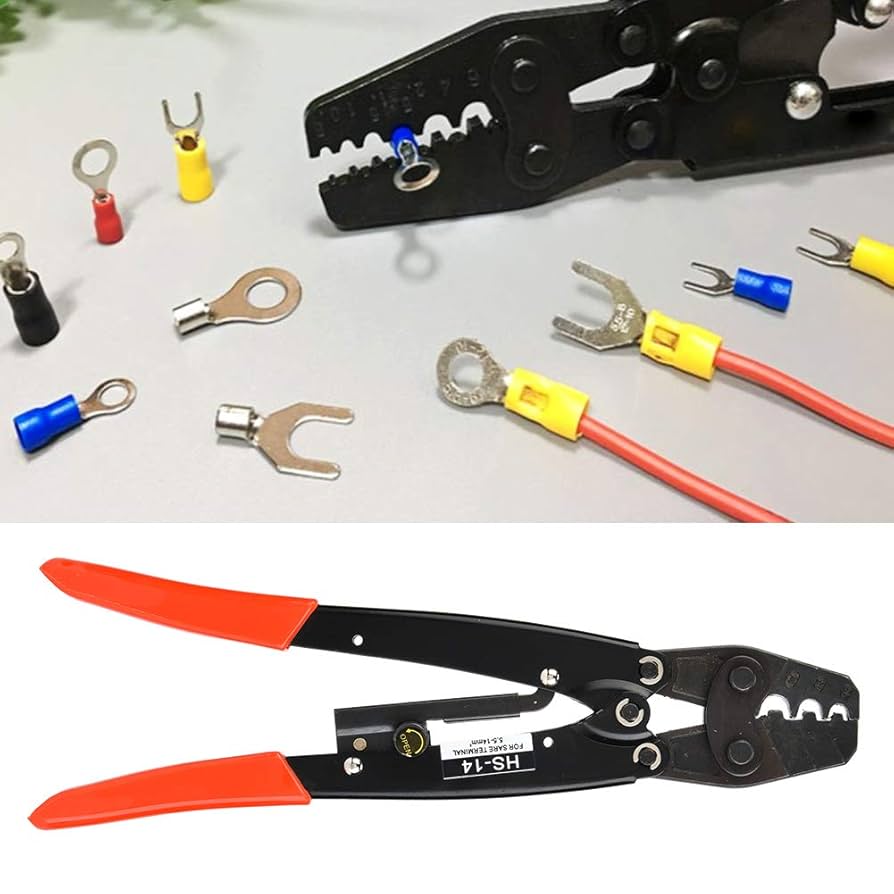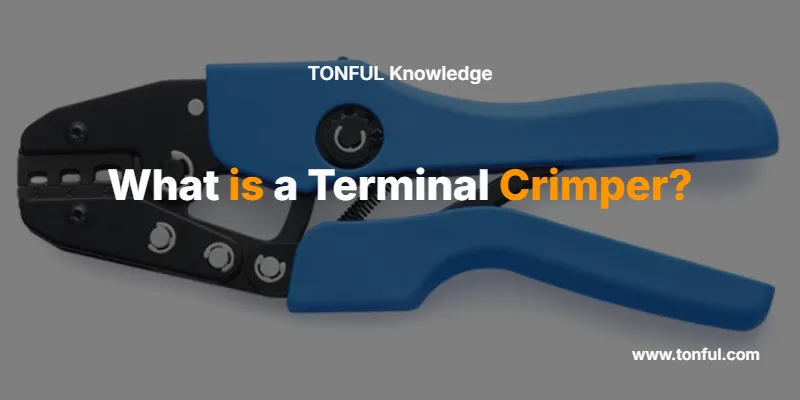A terminal crimper is a specialized hand tool designed to securely attach electrical terminals and connectors to wire ends by mechanically deforming (crimping) the terminal around the wire. This creates a gas-tight, permanent electrical connection that’s both mechanically strong and electrically reliable, making it essential for automotive, marine, industrial, and residential electrical applications.
Understanding terminal crimpers is crucial for anyone working with electrical systems, as proper crimping ensures safe, code-compliant connections that won’t fail under stress, vibration, or environmental conditions.

What Makes a Terminal Crimper Different from Other Tools?
Terminal crimpers are purpose-built tools that differ significantly from pliers, wire strippers, or other electrical tools. Here’s what sets them apart:
Key Defining Features
Specialized Jaw Design: Terminal crimpers feature precisely engineered jaws with specific profiles (hex, square, or custom shapes) that create uniform compression around the entire circumference of the terminal.
Controlled Compression Force: Unlike regular pliers, terminal crimpers apply consistent, calibrated pressure that deforms the terminal without over-crushing the wire strands or under-crimping the connection.
Ratcheting Mechanism: Professional-grade crimpers include ratcheting systems that ensure complete crimping cycles and prevent partial crimps that could lead to connection failure.
Complete Terminal Crimper Types Comparison
| Crimper Type | Wire Range (AWG) | Terminal Types | Typical Cost | Best Applications | Jaw Configuration |
|---|---|---|---|---|---|
| Manual Hand Crimpers | 22-10 AWG | Insulated terminals, ring/spade | $15-$75 | Light automotive, household | Fixed hex or square |
| Ratcheting Crimpers | 22-8 AWG | Multiple terminal types | $45-$200 | Professional electrical work | Interchangeable dies |
| Hydraulic Crimpers | 4/0-500 MCM | Heavy-duty lugs, bus bars | $300-$2000 | Industrial power systems | Custom heavy-duty |
| Pneumatic Crimpers | 24-4/0 AWG | High-volume production | $500-$3000 | Manufacturing assembly | Automated positioning |
| Battery-Powered Crimpers | 12-4/0 AWG | Lugs, terminals, connectors | $800-$4000 | Field service, mobile work | Portable precision |
Primary Applications and Use Cases
Automotive Applications
- Battery cable connections: Crimping battery terminals to heavy-gauge cables
- Trailer wiring: Creating weatherproof connections for lighting circuits
- Audio system installation: Securing amplifier and speaker connections
- Engine harness repair: Replacing damaged connectors in wiring harnesses
Marine and Outdoor Applications
- Boat wiring systems: Creating corrosion-resistant connections in wet environments
- Solar panel installations: Securing DC connections in photovoltaic systems
- Outdoor lighting: Weatherproof connections for landscape and security lighting
Industrial and Commercial Uses
- Control panel assembly: Connecting sensors and actuators in automation systems
- Motor connections: Securing power connections to three-phase motors
- Telecommunications: Grounding connections and equipment bonding
- HVAC systems: Control circuit connections and motor wiring
How Terminal Crimpers Work: Step-by-Step Process
Step 1: Wire Preparation
- Strip wire insulation to manufacturer specifications (typically 1/4″ to 3/8″)
- Inspect wire for damage, fraying, or contamination
- Clean copper strands if oxidized or dirty
Step 2: Terminal Selection and Insertion
- Select appropriate terminal size for wire gauge
- Insert stripped wire fully into terminal barrel
- Ensure no copper strands extend beyond terminal
Step 3: Crimping Process
- Position terminal in correct crimper jaw cavity
- Align wire and terminal perpendicular to crimper jaws
- Squeeze handles firmly through complete ratchet cycle
- Release handles to open jaws and remove crimped connection
Step 4: Connection Inspection
- Verify terminal is fully compressed around wire
- Check that no wire strands are visible outside terminal
- Perform gentle pull test to ensure mechanical integrity
⚠️ SAFETY WARNING: Always wear safety glasses when crimping. Flying metal particles can cause eye injury. Never attempt to stop a ratcheting crimper mid-cycle as this can damage the tool and create unsafe partial crimps.
Terminal Crimper Selection Guide
What Wire Gauge Range Do You Need?
Light Duty (22-16 AWG): Basic automotive accessories, household electronics
- Recommended: Standard manual crimpers ($20-$40)
- Features needed: Insulated terminal compatibility
Medium Duty (14-10 AWG): Automotive main circuits, appliance connections
- Recommended: Ratcheting crimpers ($50-$120)
- Features needed: Multiple die sets, consistent compression
Heavy Duty (8-4/0 AWG): Battery cables, welding leads, industrial power
- Recommended: Hydraulic or battery-powered ($300-$1500)
- Features needed: High compression force, large jaw opening
Professional vs. DIY Considerations
| Factor | DIY/Occasional Use | Professional/Daily Use |
|---|---|---|
| Build Quality | Basic steel construction acceptable | Tool steel, hardened jaws required |
| Ratcheting | Optional for light work | Mandatory for consistency |
| Warranty | 1-year sufficient | 3+ years with repair service |
| Calibration | Not critical | Annual calibration recommended |
| Die Options | Single size acceptable | Multiple die sets essential |
Essential Features Checklist
Must-Have Features:
- Proper wire gauge range for your applications
- Comfortable, non-slip grips
- Clear gauge markings on jaws
- Smooth ratcheting action (for professional use)
- Durable construction with replaceable parts
Professional Upgrade Features:
- Interchangeable die sets
- Calibration markings and certificates
- Carrying case with die storage
- Quick-release ratchet override
- Built-in wire strippers
Safety Requirements and Code Compliance
Electrical Code Compliance
Terminal crimping must comply with relevant electrical codes:
NEC (National Electrical Code): Requires UL-listed terminals and proper crimping methods for all electrical installations.
SAE Standards: Automotive applications must meet SAE J1128 specifications for terminal crimping in vehicle wiring.
Marine Standards: ABYC (American Boat and Yacht Council) requires tinned copper terminals and waterproof crimping for marine applications.
Safety Best Practices
Personal Protective Equipment:
- Safety glasses (mandatory)
- Work gloves when handling sharp terminals
- Non-conductive mat when working on live circuits
Work Environment:
- Adequate lighting for proper terminal alignment
- Clean, organized workspace free of distractions
- Proper ventilation if using flux or cleaning solvents
⚠️ CRITICAL SAFETY NOTE: Never crimp terminals on energized circuits. Always de-energize and lock out electrical systems before beginning work.
Common Problems and Troubleshooting
Poor Crimp Quality Issues
| Problem | Cause | Solution |
|---|---|---|
| Loose connection | Insufficient compression | Use proper die size, complete ratchet cycle |
| Wire pullout | Wrong terminal size | Match terminal to wire gauge exactly |
| Cracked terminal | Over-crimping | Reduce compression force, check die wear |
| Uneven crimp | Misaligned terminal | Center terminal in jaw before crimping |
Tool Maintenance Requirements
Daily Maintenance (Professional Use):
- Clean jaws of debris and wire fragments
- Check ratchet mechanism operation
- Inspect dies for wear or damage
Monthly Maintenance:
- Lubricate pivot points with light machine oil
- Verify calibration with crimp pull tester
- Replace worn or damaged dies
Annual Service:
- Professional calibration and adjustment
- Complete disassembly and cleaning
- Replacement of worn internal components
Expert Tips for Professional Results
🔧 PRO TIP: Always match your crimper’s die to the terminal manufacturer’s specifications. Generic dies may not provide proper compression profiles, leading to connection failure.
🔧 PRO TIP: For critical applications, invest in a crimp pull tester ($200-$500) to verify connection strength meets industry standards.
🔧 PRO TIP: Store crimpers in a dry environment and apply light oil to prevent jaw corrosion, especially in marine or industrial environments.
🔧 PRO TIP: Keep detailed records of crimp quality for commercial work. Many electrical inspectors require documentation of proper crimping procedures.
When to Call a Professional
While basic terminal crimping is accessible to DIYers, certain situations require professional expertise:
Requiring Professional Installation:
- High-voltage industrial connections (over 600V)
- Critical safety systems (fire alarms, emergency lighting)
- Commercial electrical panels and distribution systems
- Marine electrical systems requiring ABYC compliance
- Aerospace or medical device applications
Professional Certification Requirements
Many jurisdictions require licensed electricians for:
- Commercial building electrical work
- Industrial motor control systems
- Public infrastructure electrical connections
- Code-compliance inspections and sign-offs
Frequently Asked Questions About Terminal Crimpers
What’s the difference between crimping and soldering terminals?
Crimping creates a mechanical connection through compression, while soldering uses heat and metal alloy. Crimping is preferred for automotive and industrial applications because it’s faster, doesn’t require heat, and creates connections that handle vibration better than solder joints.
How do I know if my crimp connection is good?
A proper crimp should show slight barrel deformation with no gaps, the wire should not pull out with moderate force, and you should see no copper strands extending beyond the terminal. Professional applications require pull testing to verify connection strength.
Can I use regular pliers instead of a terminal crimper?
No. Regular pliers create uneven pressure that can damage wire strands and create unreliable connections. Terminal crimpers apply controlled, uniform compression that’s essential for safe, long-lasting electrical connections.
What wire gauge requires what size terminal?
Terminal sizing follows AWG standards: 22-18 AWG uses small terminals, 16-14 AWG uses medium terminals, 12-10 AWG uses large terminals. Always check terminal packaging for specific wire gauge compatibility.
How often should I replace crimper dies?
Dies should be replaced when you notice inconsistent crimp quality, visible wear on contact surfaces, or after approximately 10,000-15,000 crimps in professional use. Inspect dies monthly and replace immediately if cracked or severely worn.
Do I need different crimpers for different terminal types?
While universal crimpers handle many terminal types, specialized applications benefit from specific tools. Insulated terminals, coax connectors, and heavy-duty lugs often require dedicated crimpers for optimal results.
What’s the most important feature in a professional crimper?
Ratcheting mechanism is the most critical professional feature, ensuring complete crimp cycles and consistent connection quality. This prevents partial crimps that are the leading cause of electrical connection failures.
How do I maintain proper crimp quality in harsh environments?
Use marine-grade tinned copper terminals, apply dielectric grease before crimping, and consider heat-shrink tubing over connections. Store crimpers in dry conditions and clean jaws regularly to prevent contamination transfer.
Ready to start crimping professional-quality electrical connections? Choose the right terminal crimper for your specific applications using our comprehensive selection guide above. Remember: proper tool selection and technique are essential for safe, reliable electrical connections that meet code requirements and professional standards.
For complex electrical projects or when code compliance is critical, consult with licensed electrical professionals who have the training and certification to ensure safe, compliant installations.

